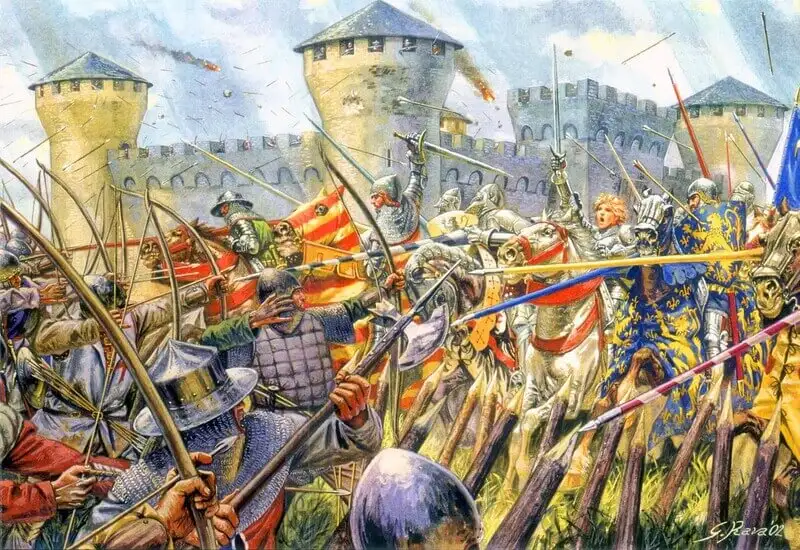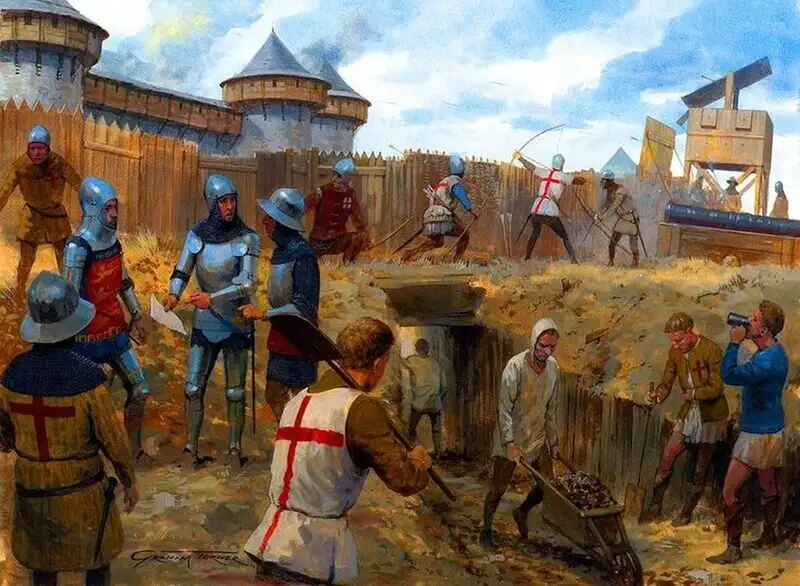The Hundred Years War (1337-1453) was a long and complex conflict between the kingdoms of England and France, sparked by territorial disputes and competing claims to the French crown. Spanning 116 years across the 14th and 15th centuries, the war began when King Edward III of England, grandson of the French King Philip IV, was denied his claim to the French throne and launched a retaliatory attack.
Though not continuous, with several periods of peace interspersed, the war featured a series of famous battles. Among them, the Battle of Agincourt stands as a vivid testament to English military prowess, while resolute leaders like Joan of Arc inspired the French to rally and defend their homeland.
Ultimately, France emerged victorious, forcing the English to withdraw from most of their territories, except for the strategic town of Calais on the English Channel coast. This protracted war left both nations exhausted but strengthened the French monarchy’s authority and redirected England toward building the British Empire.
Causes of the Hundred Years War
In the early 13th century, France had reclaimed much of its territory from England. However, the Treaty of Paris in 1259 left the Duchy of Guyenne (also known as Aquitaine) in southwestern France under English control. When King Charles IV of France died in 1328 without a male heir, his cousin Philip VI was chosen as successor instead of Charles’ nephew, King Edward III of England.
In 1337, Edward formally asserted his lawful claim to the French throne, arguing that he should rule both nations. In response, Philip declared the Duchy of Guyenne forfeit to France, prompting an English invasion that ignited the war.
The English achieved several significant victories in the war’s early phase. The naval Battle of Sluys in 1340, where Edward personally led a fleet armed with longbows, secured English control of the English Channel.
At the Battle of Crécy in 1346, Edward commanded a much smaller English force against Philip’s French army, again leveraging longbows to defeat heavily armored knights. The nearly year-long siege of Calais (1346-1347) delivered another crucial victory, capturing this strategic port, which served as an English stronghold in France for over 200 years.
The string of English successes, coupled with the capture of French King John II in 1356 and internal conflicts within the French royal family, led to the Treaty of Brétigny in 1360. Under its terms, the French king was released in exchange for a ransom, while Edward relinquished his claim to the French throne but retained control over certain French territories.

Renewed Conflict and the Rise of Joan of Arc
Following the death of King John II in 1364, his son Charles V ascended the throne and began efforts to reclaim territories France had lost to England. When the truce broke down, war resumed in 1369. Under the command of General Bertrand du Guesclin, French forces recaptured significant regions, including Normandy, Brittany, and Aquitaine.
Under King Henry V, England also revived its campaign and achieved one of the war’s greatest victories at the Battle of Agincourt in 1415. Despite the French army outnumbering the English four to one, with approximately 24,000 soldiers to England’s 6,000, the use of longbows secured a decisive English triumph.
As a result, the Treaty of Troyes in 1420 recognized Henry as heir to the French throne and arranged his marriage to Catherine, daughter of the then-reigning King Charles VI. However, a French resurgence emerged when Henry died two years later, leaving the throne to his son, Henry VI, who was only 9 months old at the time.
In 1429, Joan of Arc, a 17-year-old peasant girl who believed God had chosen her to lead France against England, persuaded King Charles VII (who ascended the throne in 1422 after his father’s death) to grant her command of an army to relieve the city of Orléans, a key French stronghold under English siege. Her success inspired the French troops, boosting morale and aiding Charles VII’s formal coronation in 1429.
Although Joan was captured and burned at the stake by the English in 1431, her leadership marked a pivotal turning point in the war, shifting the tide in France’s favor.

The End of the Hundred Years War
In 1453, as French forces repelled the English, the war entered its final phase. At the Battle of Castillon in southwestern France, the French secured a decisive victory through the innovative use of artillery tactics, effectively ending England’s claims to most French territories. The Treaty of Rocquigny in 1475 solidified France’s control over its lands, while England retained only the port of Calais, which it held until 1558.
After the war’s conclusion, France focused on recovery and strengthening its monarchy. Meanwhile, England faced civil war, known as the Wars of the Roses beginning in 1455, while shifting its efforts toward developing its navy and exploring new lands across the Atlantic.

Conclusion
The Hundred Years War (1337-1453) was not only a prolonged conflict between England and France but also a transformative chapter in European history. From territorial disputes and decisive battles like Agincourt and Castillon to the rise of historical figures like Joan of Arc, the war reshaped political, military, and economic power in both nations.
Through this article, Pywar aims to provide readers with a comprehensive perspective on this critical historical period—from its causes and developments to its outcomes. We hope to ignite a passion for exploring history and appreciating the lessons it offers from the past.
Translated by: Le Tuan
Source: history.com – Hundred Years’ War



